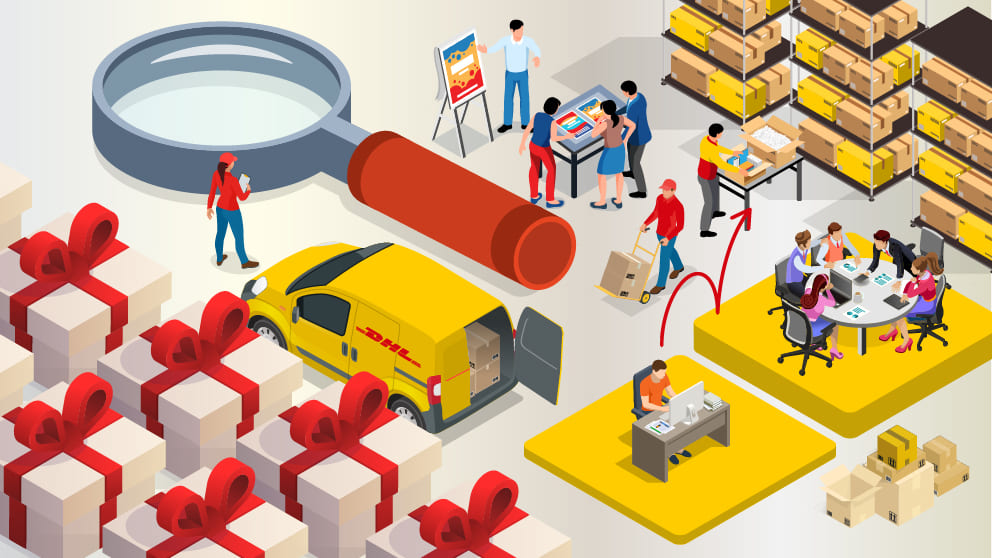Customer returns can be inconvenient, but they are an unavoidable aspect of business. Approximately 30% of online orders are returned, making returns management a significant part of daily operations for SMEs.
However, by optimising your e-commerce returns process, you can minimise costs for your business while delivering excellent service to your customers. Discover our best practices for effective returns management below.
1. Introduction to Returns Management
Returns management is the part of logistics that deals with customers returning products to retailers. It covers the return shipment, the processing of the product ready for resale, and refunding the customer – to name a few of the steps.
Efficient returns management should be a priority for small businesses; 67% of consumers will check an online retailer’s returns policy before committing to a purchase2 so it could be the difference between you making a sale or not.
An optimised returns management process will help your business deal with returns quickly so that customers receive their refunds without delay. They are more likely to become a repeat customer – and even leave your business a positive review online.
2. Challenges Faced by Small Businesses
One of the leading challenges for small businesses is the cost of product returns. 79% of consumers expect free returns when shopping online3 so it’s easy to see how they have become so expensive for retailers. In fact, it’s estimated that returns cost businesses a staggering 66% of the product’s original price4.
Processing returns can take up a lot of retailers’ time too. Items may need to be cleaned/repaired, and logged in an inventory system – all time consuming steps, particularly for small businesses with few staff and no dedicated returns infrastructure in place.
3. Benefits of Effective Returns Management
Perhaps most importantly, effective returns management will improve customer satisfaction with your brand. 84% of consumers will not shop again with a retailer after a bad returns experience5, and as any small business knows, retaining a customer is a lot cheaper than acquiring a new one.
Furthermore, if you’re looking to grow your business internationally, your returns policy could be a strong draw for shoppers. “Simple, free returns” was cited by 49% of global consumers as something that would give them confidence and reassurance to shop cross-border6.
There’s also a sustainability benefit to effective returns management. It will help your business identify alternative paths for returned products beyond just disposal or resale, such as refurbishment and recycling – and establish your brand as environmentally responsible.
4. Key Components of Returns Management
So, what steps should your business follow for an effective returns management process? Of course, the answer depends on your returns policy – but these are the general guidelines to help you optimise your operations.
Receive the product
At the point a customer initiates a return, you should ask them if they want a replacement, refund, or exchange. Once the product arrives back to your processing location, notify the customer that it has been received.
Inspect and evaluate
The product should be inspected for any damage. At this point you should decide whether the customer is eligible for a refund in line with your business’s returns policy.
Determine the product’s next destination
This is where a reverse logistics strategy comes into play. This sustainable returns model promotes the recycling, repurposing, repairing and resale of products – diverting them from landfill and saving your business money by extending the lifecycle of damaged/faulty items.
If the product is in an adequate condition for a straightforward resale, update your inventory system so that it can be made available to customers quickly.
Refund or exchange the product
It’s important to refund the customer or send them a replacement product as quickly as possible. This is key to building a positive relationship between them and your brand.
Record and analyse returns data
This is crucial. Recording the reasons customers return products to you will help you address pain points. For example, perhaps lots of customers complain a particular item is “not as described on website” – this is a sign to evaluate the product listing and add more specifications and high-res photos. Knowing exactly why your customers return products is the key to fixing the problem!
5. Best Practices for Small Businesses
Consider offering free returns
It may sound expensive – particularly for small businesses – but research7 has shown that free returns are a leading motivator for online shoppers to buy directly from a brand, so the investment could pay off for your business in terms of increased sales. Perhaps you could offer the service on a trial basis to determine if it makes financial sense.
Have a clear and concise return policy
Many visitors to your e-commerce website or app will check your return policy before committing to a purchase, so ensure it is clear, simple and fair. It should cover the cost of the return (whether it is free or if you will deduct the cost of shipping from their refund), timeframe (the window of time they have to send it back), and a FAQs section (this will reduce the number of customer enquiries you’ll have to deal with). For tips on writing a small business return policy (with free template), click here.
Prioritise speed
Customers don’t want to wait a long time for a refund or replacement product; a bad experience in this area will deter them from buying from you again.
Make them convenient
DHL Express offers an easy label-free returns service. With this, your customer makes a return request which sends a QR code to their smartphone. They can then take the parcel to a DHL Service Point (located in convenient spots like high streets and retail parks) or book a courier pick-up. Their QR code will then be scanned, and the parcel handed over into the safe hands of DHL Express. Simple! Less printing, more convenience, and sustainable, too!
Practice effective customer communication
Transparency is key. A customer returning a product to your business should be kept updated regularly. Be sure to send them a message once you have received their return, and once you approve their refund – with details on how long they should expect to wait before receiving it in their bank account.
Remember the environment
Every product that is returned essentially doubles its carbon emissions output. But, there are some sustainable steps you can take to reduce the impact. Partnering with a sustainability-focused logistics carrier is one option. DHL’s GoGreen Plus service allows customers to reduce the carbon emissions associated with their shipments through the use of Sustainable Aviation Fuel.
Adopt technology
A big challenge for small businesses is managing returns with limited staff. But there are several technologies to help you automate – and thus streamline – different stages of your returns management:
- A sophisticated Returns Management System (RMS). This cloud-based software is an end-to-end solution that will allow you to automate many aspects of returns, including returns merchandise authorisation (RMA) initiation, inventory updates, and customer notifications. Furthermore, an RMS will provide you with valuable returns data analysis to help you improve operations, reduce costs, and identify product issues.
- Implement a self-serve online returns portal into your e-commerce website. Customers can initiate the first step of the returns process via an automated system without needing input from your customer care team.
- Handheld scanners can be integrated with your reverse logistics management software. When a return arrives at your sorting facility, staff can scan the product’s barcode to automatically update the inventory database in real-time. Handheld scanners also reduce the risk of errors compared to human processing.
6. Future Trends and Innovations
AI is driving innovations in returns management including:
- Helping retailers anticipate returns rates based on customer behavior
- Recommending optimal returns policies based on a business’s specific parameters
- Detecting fraudulent returns by analysing data and detecting anomalies
For online retailers, augmented reality (AR) can help them reduce their returns rate in the first place. In the apparel industry, for example – where return rates are particularly high – many brands are enlisting AR “try-on” technology so customers can visualise how a garment will look before they commit to buy.
Small businesses without the resources to invest in such technology should instead focus on providing accurate and thorough product descriptions on their website, with plenty of high-res photos and videos. Be sure to answer customers’ questions quickly, too!
7. Conclusion
As this article has shown, the importance of implementing effective returns management practices cannot be understated. Your customers – and your bottom line – will notice! Remember these key takeaways:
- Prioritise an easy returns process for your customers. If you can afford to offer free returns, all the better – you could try this on a trial basis to measure the impact on your sales.
- Create a clear, transparent returns policy so your customers know where they stand.
- Tap into technology to automate as much of your returns logistics as possible. It will save your business time, and provide you with valuable data that will help your business address many of the pain points that are causing returns.
With a DHL Express Business Account, you’ll receive support from the experts for every part of your logistics.
1, 2, 3 - Invespcro
5 - Internet Retailing, May 2021
6 - DHL Global Online Shopper Survey 2023
7 - Statista, December 2023




















